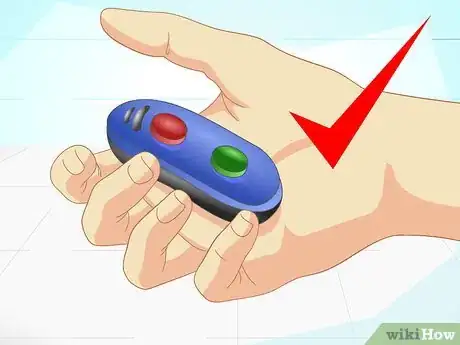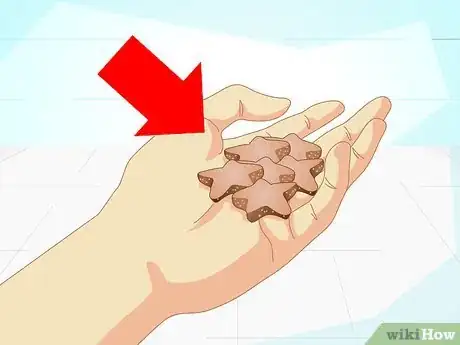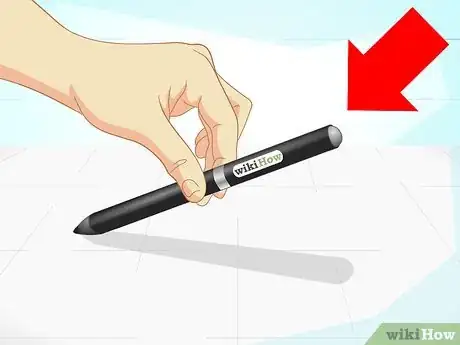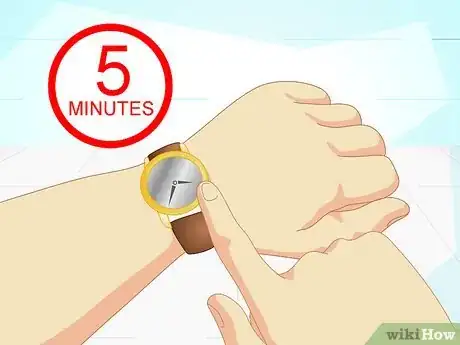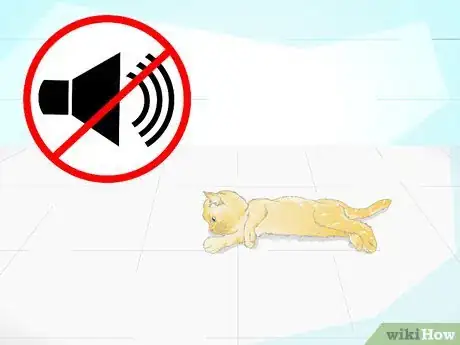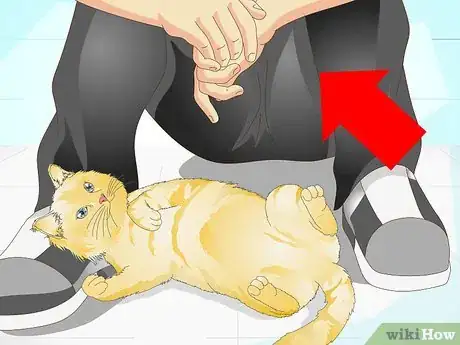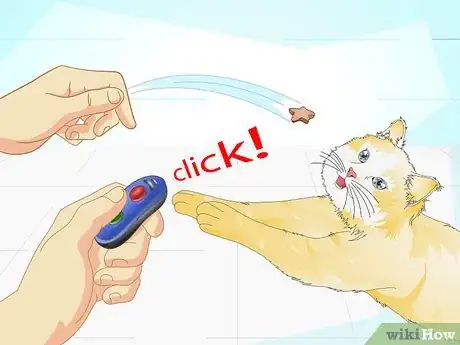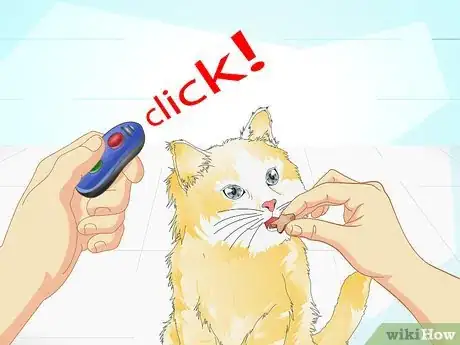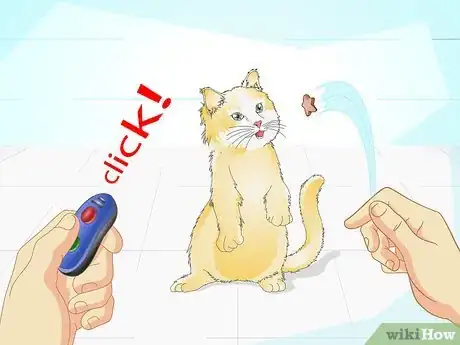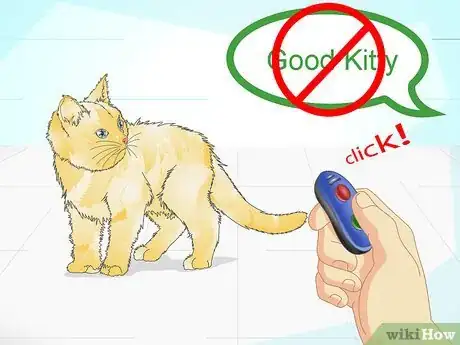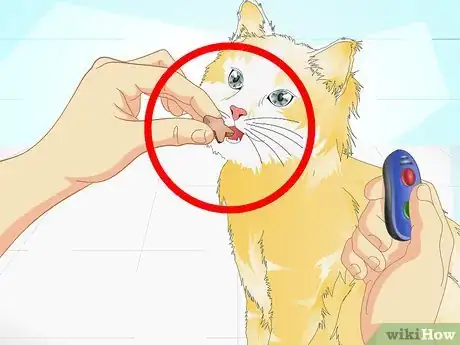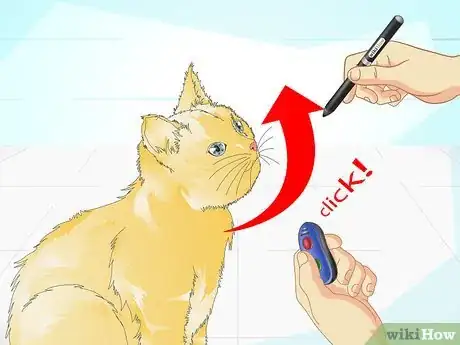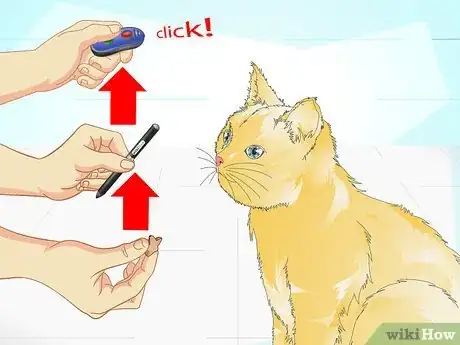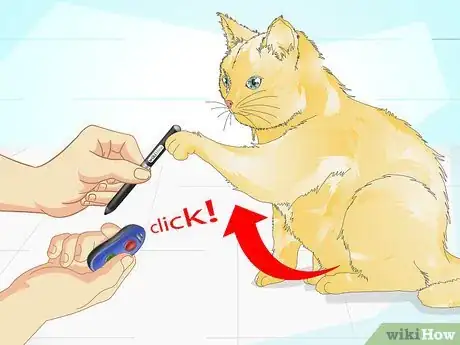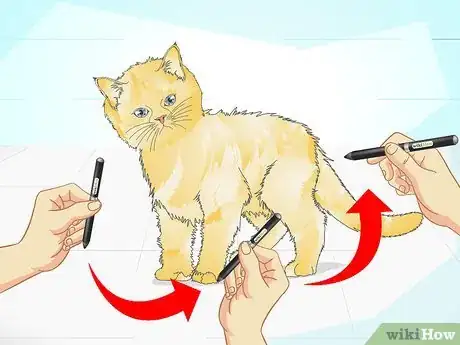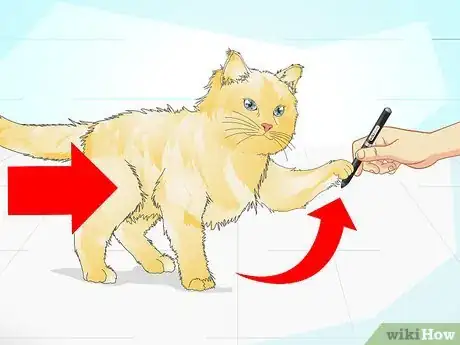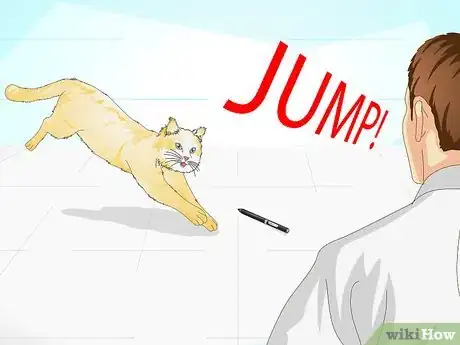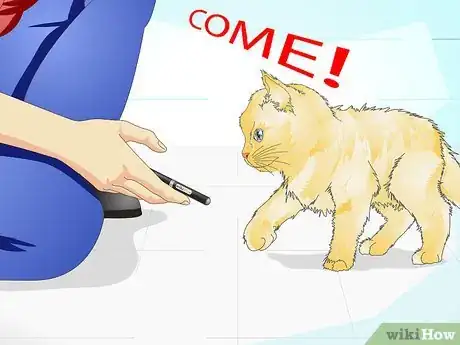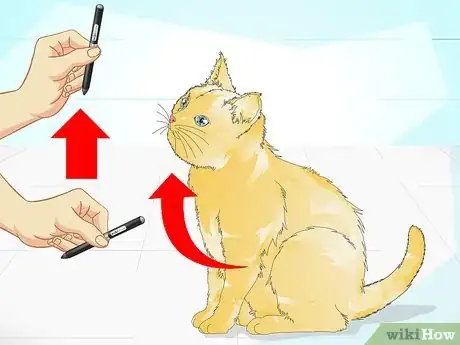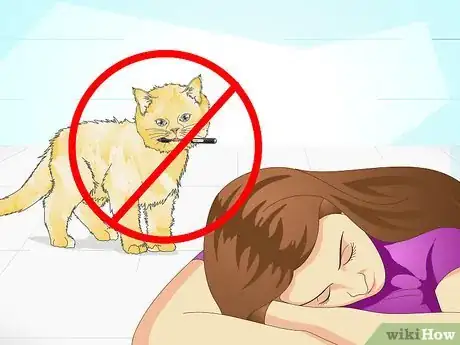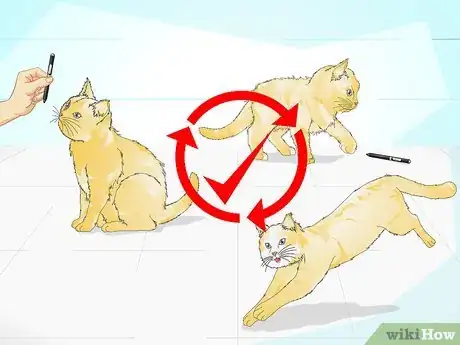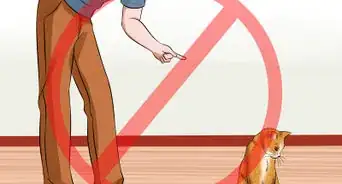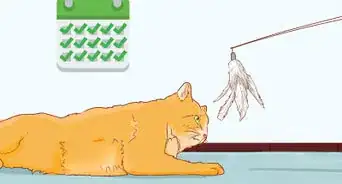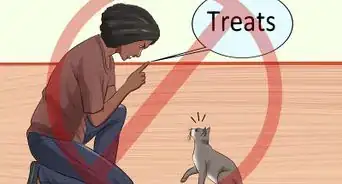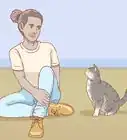This article was co-authored by Jean Johnson. Jean Johnson is a Cat Specialist and a writer for the KittyNook Blog. Jean specializes in providing advice on cat health, play, and general information about cats and cat breeds.
There are 7 references cited in this article, which can be found at the bottom of the page.
This article has been viewed 108,194 times.
Clicker training is something you usually hear of people doing with dogs, but cats can be just as easily trained. Clicker training relies on associating a clicking noise with a treat or other reward, which is given for certain positive behaviors. Approaching this training process with consistency and patience will have you teaching your cat new tricks in no time.
Steps
Getting Ready to Train Your Cat
-
1Get a clicker. A clicker is a small plastic box with a metal tab in it. When you press it, it makes a clicking sound.[1] These are available online or in pet stores, and they cost as little as $1. These are commonly used to train dogs and cats.
- It's best to use a clicker specifically designed for training. If you don't have one, though, make a distinct clicking noise with your mouth, or you can use a pen that makes a clicking sound.
- If your cat is deaf, you can use a pen light to achieve the same results.[2]
-
2Have some treats on hand. In order for the training to work, you need to give your cat a reward. A common reward is a special treat of some sort (e.g., tuna or deli turkey), and it should be something that can be given instantly to reward behavior.[3] If the treat is food, it should be cut up into pea-sized chunks.[4]
- Some cats might respond well to affection or a toy.
Advertisement -
3Get a target item. Use a stick-like object, such as a pen or a spoon. This item should be easily recognizable and used only for training. Your cat will eventually follow this object as a target, so you don't want your cat jumping up to the dinner table to follow her training spoon.
- You can make a target stick by putting a Ping-Pong ball on the end of a pencil or chopstick.[5]
- Don't use the treat as the target. This will teach your cat to do tricks only when there is a treat involved. Eventually you'll want to be able to get your cats to do tricks without treats (though you should still reward with treats sporadically).
-
4Find a good time to train. Set aside about 5 minutes for each training session, and hold these sessions a few times a day. Wait until your cat is active and hungry (it should be at least 20-30 minutes until mealtime). He will be more interested in the treat and will respond better to the training.
-
5Start in a quiet location. Start your training in a location that will be quiet and without distractions.[6] If you have other pets around, try putting them outside or in a separate room while you work on training your cat.
Associating the Click with the Reward
-
1Sit on the floor with your cat. Get down at your cat’s level to engage with him while you start the process of clicker training him. This will make it easier for you to respond immediately to your cat’s correct behavior by clicking and giving him a treat.
-
2Use the clicker and give a reward. Toss over a treat for your cat while making the clicking noise at the same time. This will begin an association in the cat’s mind that a clicking sound will mean a treat will appear.[7] [8]
- Don't click at any other time. You want the cat to associate the click with the treat, so don’t click while the cat is eating, looking at you, or walking away. Only click when you give the treat.
-
3Repeat clicking and rewarding several times. Wait until your cat is finished eating the treat and looks at you before you start again. Make the clicking sound and toss over a treat again. Let your cat finish the treat before starting again. Try this process several times. Stop after 5 minutes and give your cat a break.
- If the cat completely loses interest, the reward isn't strong enough. Find a better reward.
-
4Toss the treat a little ways and click at the same time. Continue to associate the clicking sound with the reward, but use your cat’s attention to the treat to start building some stronger associations. The cat will still want the treat but will have to work harder for it (here, your cat will just take a few steps, but soon, your cat will need to perform for the treat).
-
5Don’t talk to your cat during this time. Don't talk to the cat or use any kind of verbal cues during this first stage. You want the clicker noise to be the clearest signal here.
- The click noise is also much easier for an animal to identify than a verbal cue, such as saying, “Good kitty.” Your timing might not be as exact, and the cat might pick up on your tone differently every time. A click is quick and consistent.
Introducing a Target
-
1Reinforce the click/treat relationship briefly. In the beginning, every time you start a new training session, reinforce the click/treat relationship by clicking the clicker and giving your cat a treat. This will remind your cat of this association.
-
2Associate the click with the target. Bring your target item over to your cat. Be prepared to click as soon as the cat makes any movement towards the target or shows interest in it. He might look at it, lean toward it, approach it, or sniff it, for example. Click at the same time as his sniff or other movement, and give him a treat.
- Hide the target in between each click, so that your cat only sees it when you’re ready to reward it appropriately.
- The click lets the cat know the exact moment at which it did something right. In this case, the correct action is moving toward the target. Using the clicker as a signal for the reward will make sure your cat doesn’t get confused. If you toss the cat a treat when he looks at the target, he will immediately get distracted and focus on the treat. Instead, the clicker tells the cat that the treat is coming, and the cat has a little more time to figure out what it did to get the treat.
-
3Try again several times. Once he’s finished his treat, bring up the target again and click when he makes any movement towards it. Immediately give him a treat. He will start to associate the target with the treat, and will try different movements to get that treat.[9]
- If the cat is only looking at the target, move the target closer to its face. Most cats will lean in to sniff it. As soon as the cat does this, click and then reward.
-
4Wait for the cat to touch the target. After the cat has associated a click (and treat) with the target, push him a little to perform more. Wait for the cat to brush his face on the target, for example, before clicking and giving him the treat.[10]
-
5Move the target around. Now you can start to move the target so that your cat will also move. Encourage your cat to take a step toward the target. Once the cat is reliably looking at target every time you introduce it, try to get the cat to take a step in its direction. As soon as it takes that step, click and reward.[11]
- Try moving the target over to the side. When your cat follows the target, click and give a reward. Taking an incremental approach will be productive, because cats won’t complete the entire action you want the first time. Give rewards when your cat makes partial movements in the right direction. As you keep training, you reward him for getting closer and closer to the complete action.
-
6Repeat this exercise a few times a day. Try 5 minute sessions at most. If you notice your cat losing interest and starting to clean himself after 10-15 clicks, end the training session. Eventually you'll probably be able to get your cat to walk across the room to the target.
Introducing Verbal Cues
-
1Decide on a verbal cue for each of your cat's tricks. While the clicker noise is good for letting the cat know what it's doing right, verbal cues can be used once the cat has already learned a few tricks, to help it understand which trick you want it to do. The verbal cue must be distinct and clear. It should be a word you won't use with other pets, or a word that is used too much in everyday conversation.
- Choose a logical word to make your cat do something. You might use “Jump!” for when your cat jumps onto something. You might use “Come!” for when your cat walks toward you.
-
2Teach your cat to come. Sit on the floor and hold out the target. If your cat will respond to the target by walking toward it, try holding it in front of you and say, “Come!” at the same time. When your cat moves towards the target (and you), click and give a reward.
- Try this several times in different locations in your house. Make sure you click and reward each time.[12]
- If your cat is just not getting it, or if he seems confused, revert back to your previous training. End the session on a good note and try again later.
- Remember to only try these sessions for about 5 minutes at a time.
-
3Teach your cat to sit. Hold a treat above his head in your closed hand. As he sees it, move your hand back further. Most cats will naturally sit down so their head can still follow the treat. As soon as your cat sits down (or even as he starts to sit down), click the clicker, say “Sit,” and give him the treat.[13] [14]
- Repeat this several times a day.
-
4Ignore behavior performed without a verbal cue. The verbal cue signals that when your cat performs a particular behavior, he will receive a reward. If your cat does this something on his own, just don't reward him. Don't click and don't give a treat. At this stage of the training, ignore any behavior that he does without a verbal cue. This is so your cat will associate the verbal cue with the click and reward.[15]
-
5Repeat this process with other tricks. As you continue to train your cat, he will learn more commands and will recognize different verbal cues for different tricks. At some point, you'll find you don't need the clicker or the treats anymore.
Expert Q&A
-
QuestionCan cats be trained, and if so, what are the benefits of training cats?
 Pippa Elliott, MRCVSDr. Elliott, BVMS, MRCVS is a veterinarian with over 30 years of experience in veterinary surgery and companion animal practice. She graduated from the University of Glasgow in 1987 with a degree in veterinary medicine and surgery. She has worked at the same animal clinic in her hometown for over 20 years.
Pippa Elliott, MRCVSDr. Elliott, BVMS, MRCVS is a veterinarian with over 30 years of experience in veterinary surgery and companion animal practice. She graduated from the University of Glasgow in 1987 with a degree in veterinary medicine and surgery. She has worked at the same animal clinic in her hometown for over 20 years.
Veterinarian Yes, cats can be trained. Reward based training works well, with the addition of a target or a clicker. Training provides great mental stimulation for the cat, which can reduce problem behaviors such as inappropriate toileting or fighting.
Yes, cats can be trained. Reward based training works well, with the addition of a target or a clicker. Training provides great mental stimulation for the cat, which can reduce problem behaviors such as inappropriate toileting or fighting. -
QuestionHow do I keep my cat off the counter?
 Pippa Elliott, MRCVSDr. Elliott, BVMS, MRCVS is a veterinarian with over 30 years of experience in veterinary surgery and companion animal practice. She graduated from the University of Glasgow in 1987 with a degree in veterinary medicine and surgery. She has worked at the same animal clinic in her hometown for over 20 years.
Pippa Elliott, MRCVSDr. Elliott, BVMS, MRCVS is a veterinarian with over 30 years of experience in veterinary surgery and companion animal practice. She graduated from the University of Glasgow in 1987 with a degree in veterinary medicine and surgery. She has worked at the same animal clinic in her hometown for over 20 years.
Veterinarian Make sure there is nothing to attract the cat up onto the surface. Then booby trap the counter with a row of empty tin cans balanced on a tray on the edge of the counter, or use a motion activated can of compressed air, such as Sssscat cat.
Make sure there is nothing to attract the cat up onto the surface. Then booby trap the counter with a row of empty tin cans balanced on a tray on the edge of the counter, or use a motion activated can of compressed air, such as Sssscat cat. -
QuestionHow do you teach a cat to do tricks?
 Pippa Elliott, MRCVSDr. Elliott, BVMS, MRCVS is a veterinarian with over 30 years of experience in veterinary surgery and companion animal practice. She graduated from the University of Glasgow in 1987 with a degree in veterinary medicine and surgery. She has worked at the same animal clinic in her hometown for over 20 years.
Pippa Elliott, MRCVSDr. Elliott, BVMS, MRCVS is a veterinarian with over 30 years of experience in veterinary surgery and companion animal practice. She graduated from the University of Glasgow in 1987 with a degree in veterinary medicine and surgery. She has worked at the same animal clinic in her hometown for over 20 years.
Veterinarian The key factor is to find the cat's 'must have' treat. They will do pretty much anything for this, at which point reward-based training (the same as for dogs) becomes possible.
The key factor is to find the cat's 'must have' treat. They will do pretty much anything for this, at which point reward-based training (the same as for dogs) becomes possible.
Warnings
- Avoid punishing the cat in any way, especially while training. It will completely undo your progress. You're trying to teach your cat that you will give her something good when she does what you want. If you introduce punishment or fear into the situation, she will become confused and fearful.⧼thumbs_response⧽
References
- ↑ http://www.vetstreet.com/dr-marty-becker/3-tricks-to-teach-your-cat-with-a-clicker
- ↑ http://www.humanesociety.org/news/magazines/2011/05-06/it_all_clicks_together_join.html
- ↑ Jean Johnson. Cat Expert.
- ↑ http://www.petplace.com/cats/clicker-training-your-cat/page1.aspx
- ↑ http://www.vetstreet.com/dr-marty-becker/3-tricks-to-teach-your-cat-with-a-clicker
- ↑ http://www.vetstreet.com/dr-marty-becker/3-tricks-to-teach-your-cat-with-a-clicker
- ↑ Jean Johnson. Cat Expert.
- ↑ http://www.humanesociety.org/news/magazines/2011/05-06/it_all_clicks_together_join.html
- ↑ http://www.vetstreet.com/dr-marty-becker/3-tricks-to-teach-your-cat-with-a-clicker
- ↑ http://www.vetstreet.com/dr-marty-becker/3-tricks-to-teach-your-cat-with-a-clicker
- ↑ http://www.humanesociety.org/news/magazines/2011/05-06/it_all_clicks_together_join.html
- ↑ http://www.petplace.com/cats/clicker-training-your-cat/page1.aspx
- ↑ Jean Johnson. Cat Expert.
- ↑ http://www.petplace.com/cats/clicker-training-your-cat/page1.aspx
- ↑ http://www.petplace.com/cats/clicker-training-your-cat/page1.aspx
About This Article
To clicker train your cat, start by giving your cat a treat and clicking the clicker at the same time so it associates the sound with a treat. Repeat this several times in each training session. Then, click and toss the treat a few steps away from the cat so it has to retrieve it. Next, show your cat a target, like a pen. When it sniffs the target, click and give it a treat. Then, encourage it to do more before you give it a treat. For example, you could wait until it brushes its face against the target. For tips on how to introduce verbal cues and how to get your cat to do tricks, read on!
